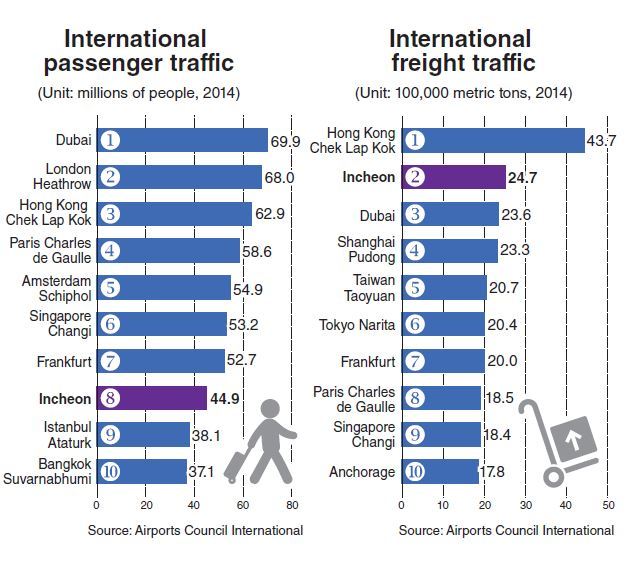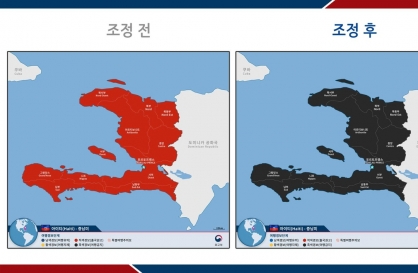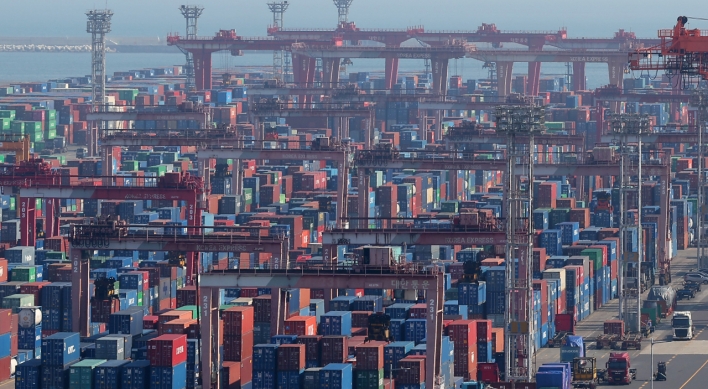
Competition among Asian air hubs is heating up as countries in the region are scurrying to build new airports, add runways and expand passenger terminals to become the continent’s top gateway to the world.
With surging air travel and burgeoning budget carriers, major airports in South Korea, China, Japan, Singapore, India and Thailand are increasing capacity to meet demand.
“Asian countries are showing a significant growth in air travel, higher than the global average, amid their continued economic growth, which leads to airports’ massive expansion and a paradigm change in the industry,” Korea Aerospace University professor Hurr Hee-young said.
Data by the Center for Asia Pacific Aviation shows that $226.8 billion will be invested in building new airports or expanding airport facilities in the Asia-Pacific. That is 37 percent of global investment, and the highest of any region in the world.
Incheon International Airport, South Korea’s main international gateway, has joined the construction boom to better handle spikes in passenger traffic that approach its maximum capacity.
It is undergoing the third phase of the expansion plan to build its second passenger terminal by 201.7 with estimated costs of 4.9 trillion won ($4.16 billion).
Once the construction is completed, the airport will be able to handle 62 million passengers and 5.8 million tons of air cargo per year with new three additional runways.
“Incheon will be able to compete with other major air hubs in earnest after the revamp, as there are only a few airports that have a capacity of 50 million passengers in the world,” Park Wan-su, CEO of the Incheon International Airport Corp said.
While the flagship airport continues to show near double digit annual growth in both international passenger and cargo traffic, aviation experts pointed out that Incheon needs to seek bigger share of transit traffic to realize its aim of becoming a major hub airport in Asia.
“Incheon airport has international competitiveness in services and operations, such as its world’s fastest immigration procedures. Now it should pay attention to the decline in the number of international passengers transferring the airport,” Hurr said.

Incheon’s share of transit passengers declined from 18.5 percent in 2013 to 15.9 percent in 2014.
Well-connected aviation hubs like Singapore’s Changi Airport can’t ignore the soaring air travel demand. The airport plans to ramp up its capacity by building a fifth terminal and a third runway, with the projects to be completed in the middle of the next decade. A fourth terminal is currently under construction.
“Once-sleepy Asian airline and airport peers are waking up and taking back the traffic Incheon has attracted. Long-haul growth is occurring out of Beijing, Tokyo, Hong Kong and Taipei,” the Center for Aviation said in a report.
China excels other Asian countries in the number of airport construction projects and the amount of capital investment.
The Chinese aviation market is being lifted by rising business travel and a surge in outbound tourism fueled by an increasingly wealthy middle class in coastal and inland cities.
To reflect such social and economic changes, a second airport is currently under construction in Daxing District, in the south of Beijing. The new facility is estimated to cost $13.1 billion and is scheduled to open in 2018.
The new international airport will be able to handle 72 million passengers before 2025 and eventually handle 100 million passengers, Chinese authorities said.
The Chinese government also plans to spend $78 billion to build more regional airports. By 2020, the country is projected to have 260 airports, up from 202 at the end of 2014.
Some Japanese airports are responding to the needs of terminals dedicated to budget airlines, as nearly 60 percent of all airline seats in Southeast Asia are on low-cost carriers.
In April, Japan’s Narita International Airport opened a terminal for budget airlines to court a growing number of low-cost carriers for domestic and short-haul overseas flights.
At Osaka the airport operator is considering constructing a fourth terminal dedicated to LCCs at Kansai Airport. Kansai Airport has witnessed consistent growth during the last four years. LCC capacity share has grown to over one-third of the total.
By Park Han-na (hnpark@heraldcorp.com)
-
Articles by Korea Herald






![[News Focus] Lee tells Yoon that he has governed without political dialogue](http://res.heraldm.com/phpwas/restmb_idxmake.php?idx=644&simg=/content/image/2024/04/29/20240429050696_0.jpg&u=20240429210658)












